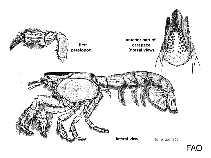Upogebia capensis (Krauss, 1843)
Cape mud shrimpWarning: DOMDocument::load(): SSL operation failed with code 1. OpenSSL Error messages: error:140770FC:SSL routines:SSL23_GET_SERVER_HELLO:unknown protocol in C:\Apache24\htdocs\includes\SpeciesSummary.lib.php on line 1236
Warning: DOMDocument::load(): Failed to enable crypto in C:\Apache24\htdocs\includes\SpeciesSummary.lib.php on line 1236
Warning: DOMDocument::load(https://sealifebase.nrm.se/webservice/AquaMaps/getAMap.php?genus=Upogebia&species=capensis): failed to open stream: operation failed in C:\Apache24\htdocs\includes\SpeciesSummary.lib.php on line 1236
Warning: DOMDocument::load(): I/O warning : failed to load external entity "https://sealifebase.nrm.se/webservice/AquaMaps/getAMap.php?genus=Upogebia&species=capensis" in C:\Apache24\htdocs\includes\SpeciesSummary.lib.php on line 1236
Envoyez vos Photos
Images Google | No image available for this species;
drawing shows typical species in Upogebiidae.
Images Google | No image available for this species;
drawing shows typical species in Upogebiidae.
Classification / Names Common names | Synonyms | CoL | ITIS | WoRMS
| Decapoda | Upogebiidae
Environment: milieu / climate zone / depth range / distribution range Écologie
. Subtropical; 26°S - 37°S, 16°E - 35°E (Ref. 4)
Distribution Pays | Zones FAO | Écosystèmes | Occurrences | Introductions
Southeast Atlantic and Western Indian Ocean: South Africa and Mozambique.
Length at first maturity / Taille / Poids / Âge
Maturity: Lm ? range ? - ? cmCommon length : 1.6 cm TL mâle / non sexé; (Ref. 4)
Description synthétique Morphologie
Rostrum ending in three teeth; the lateral teeth are placed at the end of a ridge that is separated from the central part of the dorsal surface of the rostrum by a deep groove. On the central part itself a very shallow median groove is present. There are no ventral teeth on the rostrum. The anterolateral border of the carapace with a single spine behind the eye. First pereiopods subchelate. Dactylus of adult male with a longitudinal groove on either lateral surface, and without a tooth on the cutting edge. Palm with 2 dorsal denticulate carinae. Merus without an anterodorsal spine. Coxae of first three pereiopods without spines (Ref. 4).
It has lengths of 1.5 to 1.6 cm, total body length; 2.7 to 6.5 cm, ovigerous females (Ref. 4). It burrows in sandy mud of estuaries form mid-tide to LWS [= Low water spring tide]. It is a detritus feeder (Ref. 4).
Life cycle and mating behavior Maturité | Reproduction | Frai | Œufs | Fécondité | Larves
Members of the order Decapoda are mostly gonochoric. Mating behavior: Precopulatory courtship ritual is common (through olfactory and tactile cues); usually indirect sperm transfer.
Référence principale
Références | Coordinateur | Collaborateurs
Holthuis, L.B. 1991. (Ref. 4)
Statut dans la liste rouge de l'IUCN (Ref. 130435)
statut CITES (Ref. 108899)
Not Evaluated
CMS (Ref. 116361)
Not Evaluated
Menace pour l'homme
Utilisations par l'homme
Appât: usually
| FishSource |
Outils
Plus d'informations
Pays
Zones FAO
Écosystèmes
Occurrences
Introductions
Stocks
Écologie
Régime alimentaire
Éléments du régime alimentaire
Zones FAO
Écosystèmes
Occurrences
Introductions
Stocks
Écologie
Régime alimentaire
Éléments du régime alimentaire
Sources Internet
BHL | BOLD Systems | CISTI | DiscoverLife | FAO(Publication : search) | Fishipedia | GenBank (genome, nucleotide) | GloBI | Gomexsi | Google Books | Google Scholar | Google | PubMed | Arbre de Vie | Wikipedia (Go, chercher) | Zoological Record
Estimates based on models
Catégorie de prix
(Ref. 80766):
Unknown.



